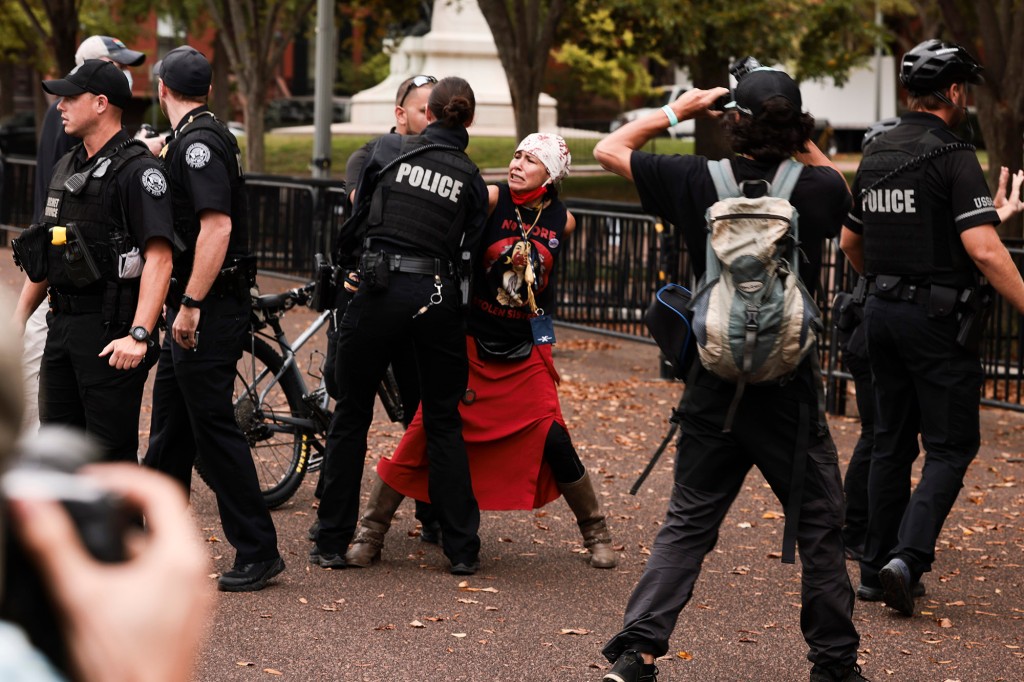At least one person was arrested Monday during a raucous climate change protest outside the White House on Indigenous Peoples’ Day, where a large group of indigenous people gathered to urge President Biden to stop approving fossil fuel projects and declare a national climate emergency.
Dozens of people gathered in front of the White House carrying signs that read “Protect Native Lands,” “Biden, reject fossil fuel projects” and “Defund Line 3,” to kick off a week of demonstrations after marching from Freedom Plaza to the White House. The protest got heated as one was arrested and others pushed up against the US Secret Service through a temporary fence.
The indigenous woman arrested was detained by Secret Service officers after she allegedly threw something over the fence of the White House. She was heard screaming, “I don’t want to die,” as she was detained.

Throughout the protests, many were seen singing and praying, while a statue of former President Andrew Jackson was defaced in front of the White House.
In bright red letters, the words “Expect us” were painted on the statue’s pedestal.
Indigenous people have long slammed Jackson for his treatment of Native Americans during his presidency, particularly his Indian Removal Act that led to the Trail of Tears.


Around 10:20 a.m., US Park Police reportedly warned the protesters to leave or be arrested. Dozens stayed on the sidewalk outside the White House following the warning.
Per the Washington Post, the demonstrators were then escorted to a tent, issued citations and released.
After sectioning off the press from the demonstrators, police reportedly threatened to arrest members of the press who didn’t immediately “just go with the rest of them.”


The US Secret Service did not immediately respond to The Post’s request for information on how many demonstrators were arrested.
Monday’s protesters were made up of leaders and members of Native American tribes from across the country, including Casey Camp-Horinek, a Native American activist and member of the Ponca Tribe of Oklahoma.
Leading up to the demonstrations, Camp-Horinek told the Washington Post that if the activists needed to be arrested to “call attention to what the crisis is and that we need a climate emergency declared, we’ll do that.”


“There’s been 500 years of people coming into a territory where all things were interdependent and functioning to a time of crisis, where even Biden’s great-grandchildren won’t survive if something doesn’t change,” said Camp-Horinek, 73.
This week’s demonstrations, known as People vs. Fossil Fuels protests, are put on by Build Back Fossil Free, a coalition of groups that are demanding Biden cut fossil fuel projects.
Organizers reportedly expect thousands to join in the entirety of the demonstrations, and roughly 300 per day.

Many held signs protesting Line 3, an oil pipeline that carries 760,000 barrels of oil a day from Canada through Minnesota and Wisconsin. Critics claim the pipeline violates treaty-protected tribal land. Oil reportedly began flowing through the pipeline Oct. 1.
The first day of demonstrations came on Indigenous Peoples’ Day, which coincides with Columbus Day. The holiday was rebranded to honor Native Americans instead of Christopher Columbus, who, activists claim, enabled colonization and forced assimilation of many tribes.
The protests come ahead of the United Nations climate summit in November, where world leaders will work toward creating more commitments to limit global warming.



















